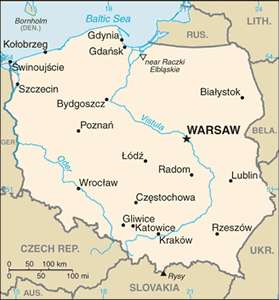The Geography of Poland
The Geography of Poland
Polish Geography
Location: Central Europe, east of Germany
Geographic coordinates: 52 00 N, 20 00 E
Map references: Europe
Area: total: 312,679 sq km land: 304,459 sq km water: 8,220 sq km
Area - comparative: slightly smaller than New Mexico
Land boundaries: total: 3,047 km border countries: Belarus 605 km, Czech Republic 615 km, Germany 456 km, Lithuania 91 km, Russia (Kaliningrad Oblast) 432 km, Slovakia 420 km, Ukraine 428 km
Coastline: 440 km
Maritime claims: territorial sea: 12 nm exclusive economic zone: defined by international treaties
Climate: temperate with cold, cloudy, moderately severe winters with frequent precipitation; mild summers with frequent showers and thundershowers
Terrain: mostly flat plain; mountains along southern border
Elevation extremes: lowest point: near Raczki Elblaskie -2 m highest point: Rysy 2,499 m
Natural resources: coal, sulfur, copper, natural gas, silver, lead, salt, amber, arable land
Land use: arable land: 40.25% permanent crops: 1% other: 58.75% (2005)
Irrigated land: 1,000 sq km (2003)
Natural hazards: flooding
Environment - current issues: situation has improved since 1989 due to decline in heavy industry and increased environmental concern by post-Communist governments; air pollution nonetheless remains serious because of sulfur dioxide emissions from coal-fired power plants, and the resulting acid rain has caused forest damage; water pollution from industrial and municipal sources is also a problem, as is disposal of hazardous wastes; pollution levels should continue to decrease as industrial establishments bring their facilities up to EU code, but at substantial cost to business and the government
Environment - international agreements: party to: Air Pollution, Antarctic-Environmental Protocol, Antarctic-Marine Living Resources, Antarctic Seals, Antarctic Treaty, Biodiversity, Climate Change, Climate Change-Kyoto Protocol, Desertification, Endangered Species, Environmental Modification, Hazardous Wastes, Kyoto Protocol, Law of the Sea, Marine Dumping, Ozone Layer Protection, Ship Pollution, Wetlands signed, but not ratified: Air Pollution-Nitrogen Oxides, Air Pollution-Persistent Organic Pollutants, Air Pollution-Sulfur 94
Geography - note: historically, an area of conflict because of flat terrain and the lack of natural barriers on the North European Plain


